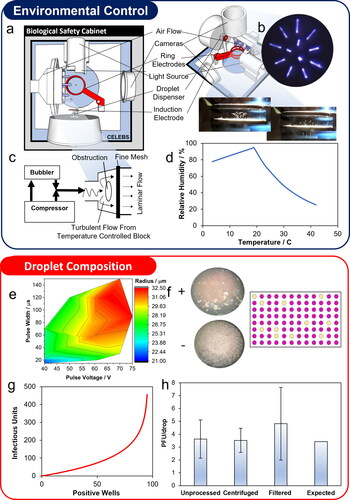Figures & data
Figure 1. Overview of CELEBS instrument and experimental procedure. (a) Top-down schematic of the CELEBS instrument. (b) Image from top-down camera within instrument showing 12 levitating droplets. (c) Schematic of the airflow as it enters the CELEBS chamber. (d) Maximum RH accessible as a function of the temperature between the rings. As the temperature deviates from room temperature (21 °C) the range of accessible RH’s decreases. (e) Contour graph of the radius of water droplets generated by a dispenser (30 µm orifice) as a function of the voltage and width of the electrical pulse sent to the dispenser. (f) Images from wells containing 17CL-1 cells, displaying CPE as a result of MHV infection (top) and an uninfected well (bottom), alongside an example schematic distribution of CPE positive wells in a plate inoculated with levitated virus. (g) Relationship between CPE positive wells and actual infectious units calculated using the Poisson distribution equation. (h) Infectious virus per droplet (bars show the mean of 3 levitations, error bars show the standard deviation) reported from 5 s levitations, with unprocessed virus culture, virus culture centrifuged at 6000 g for 2 min, virus culture passed through a 0.45 µm filter, and the expected virus per droplet value calculated from the concentration of the virus stock (measured using TCID50) and the expected droplet volume.

Figure 2. Demonstration of CELEBS study of viral airborne stability using MHV. Data are the mean of ≥3 measurements with error bars showing standard error. Percentage infectivity from individual measurements used to generate a–e are found in Table S1 (supplementary material). (a) 10-min decay curve of percentage infectivity with MHV levitated in DMEM droplets at 50% RH, 21 °C. (b) Investigation of the effect of RH on MHV airborne stability in DMEM droplets at 2 min and 5 min, 21 °C. (c) Investigation of the influence of temperature on MHV airborne stability in DMEM droplets at 5 min, 30% RH. (d) The relationship between absolute humidity and airborne stability of MHV at 5 min (data from (b) and (c)). (e) 1 h decay curve of percentage infectivity over time for MHV levitated in DMEM droplets at 30% RH, 21 °C. Inset into top right corner of figure is enlarged view of the first 5 min of the curve. (f) Investigation of the impact of airborne transport on the subsequent surface stability of MHV. Blue bars show the % infectivity of MHV in 50 µl DMEM droplets pipetted directly onto the surface and incubated at 21 °C, 30% RH for 1 h. Orange bars show the % infectivity of MHV in DMEM droplets deposited onto the surface and incubated for 1 h at 21 °C, 30% RH after being first levitated in CELEBS for 30 s at 21 °C, 30% RH.

